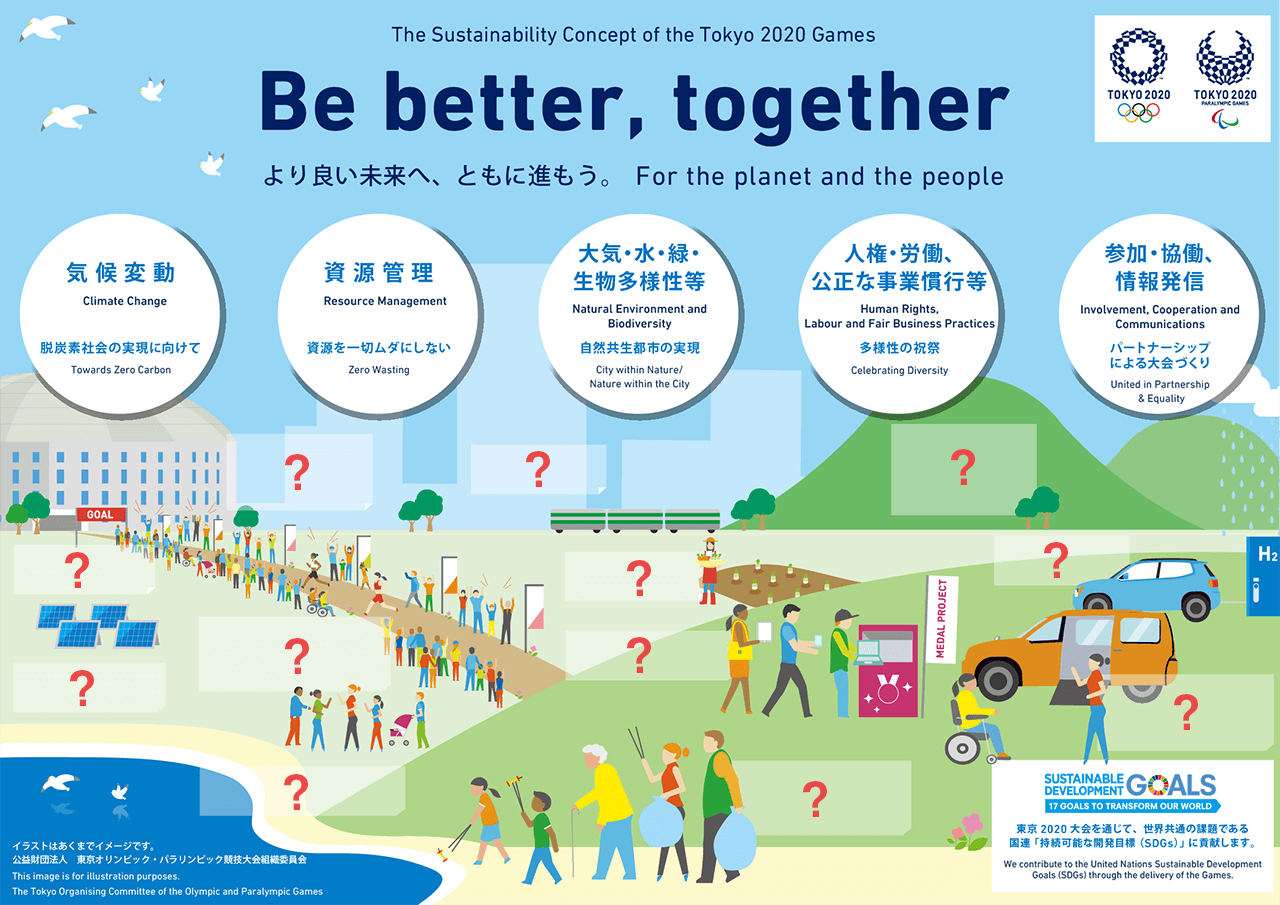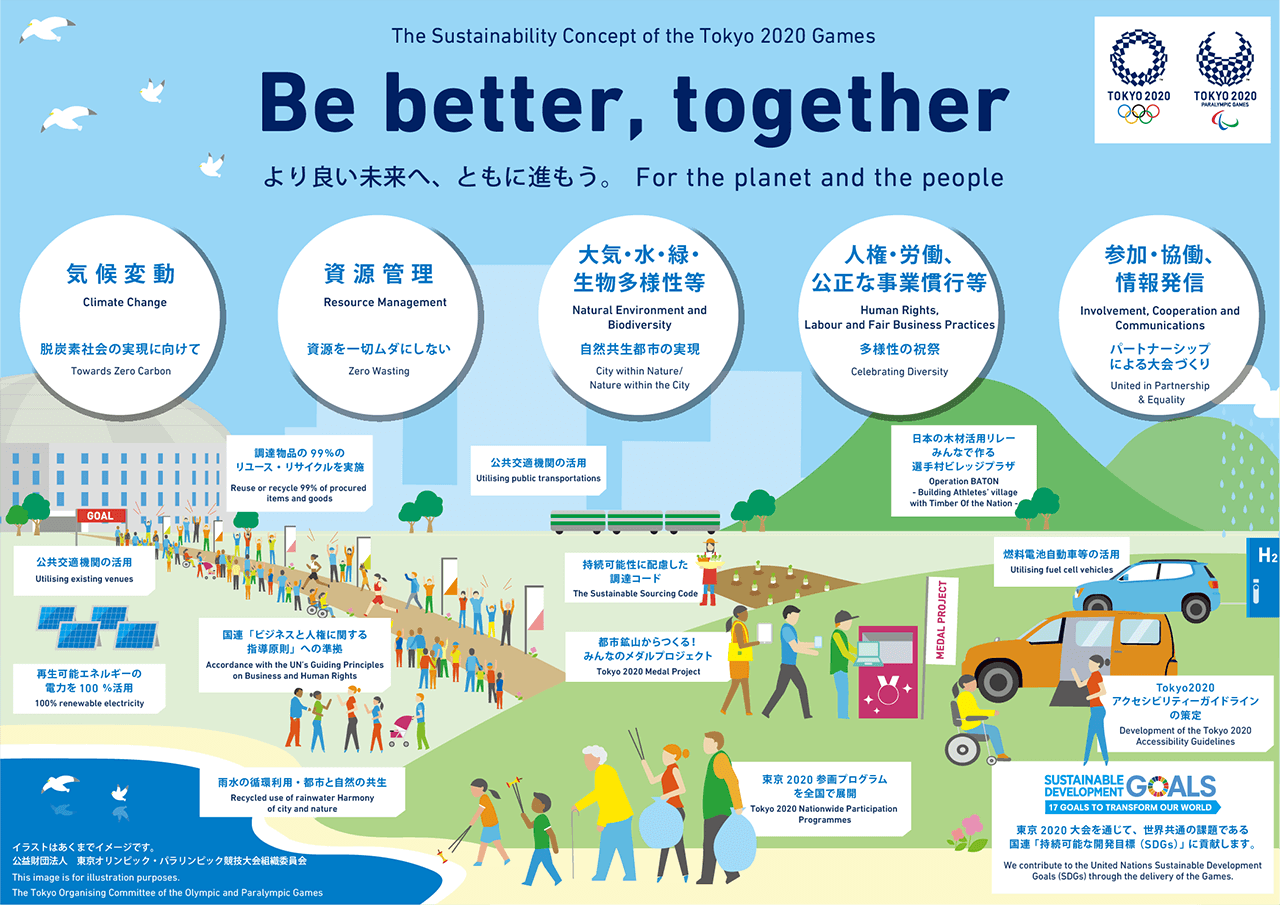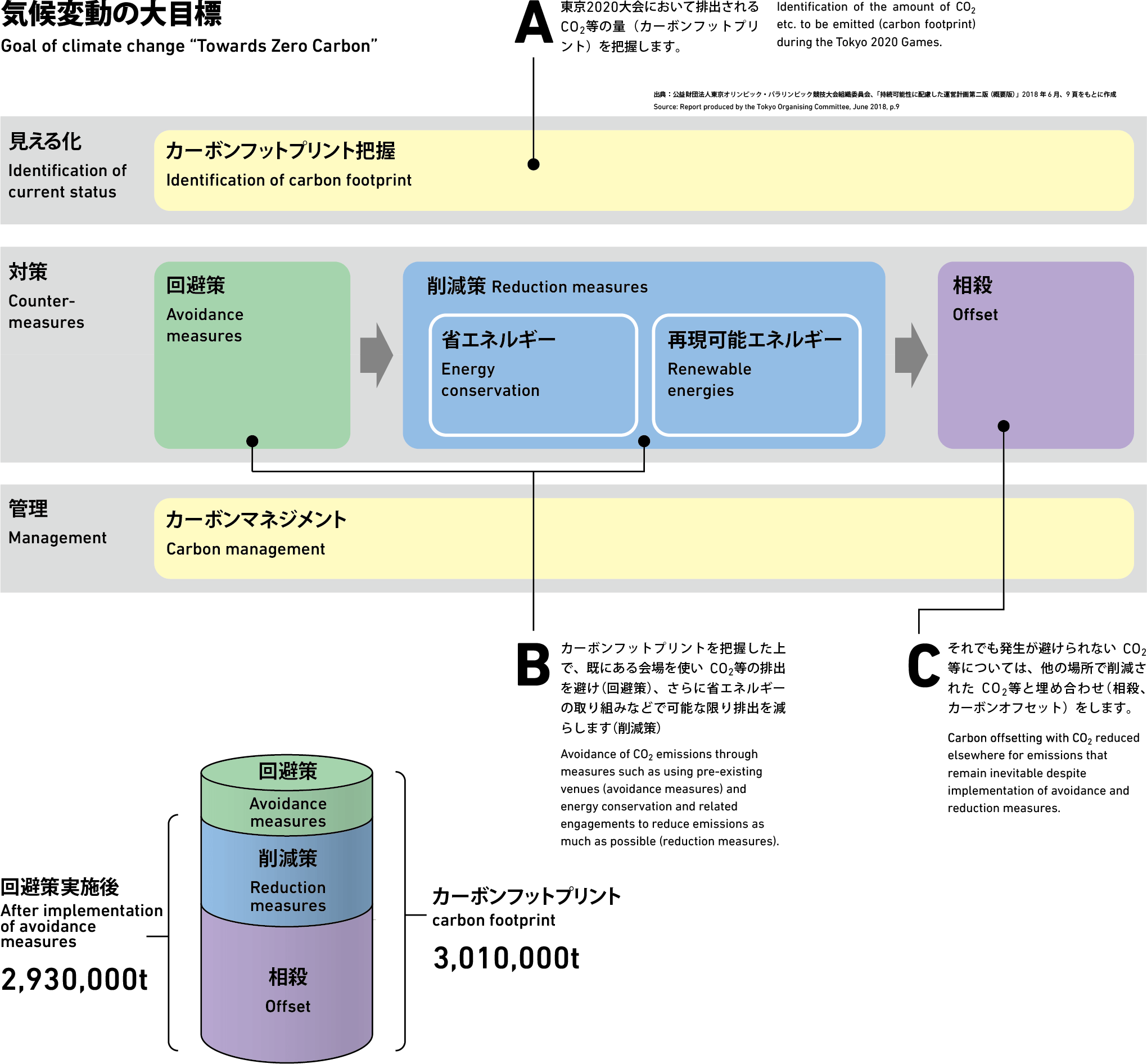気候変動とスポーツの祭典脱炭素社会の実現に向けて
1994年リレハンメル・オリンピックのスローガンは「環境にやさしいオリンピック」でした。そして、迎えた『東京2020』。オリンピックレガシーとして、次の世代につなげるための「今」の取り組みが行われています。
The slogan of the 1994 Lillehammer Olympic Games was "Environmentally friendly Olympics”. And now comes the “Olympic Games Tokyo 2020”. Let us explore its legacy by focusing on the current efforts undertaken by Tokyo 2020.
東京2020大会の持続可能性コンセプトThe sustainability concept of the Tokyo 2020 Games
このイラストは、東京2020大会の持続可能な準備と運営に向けて、大会実施パートナーが取り組む持続可能な社会の実現に向けての5つの主要テーマと具体的な課題解決のモデルを国内外に示しています。
This illustration shows the model of five key themes with concrete problem-solving initiatives for a sustainable society in Japan and the rest of the world. These are the themes and initiatives in which partners of the Tokyo 2020 Games will be engaged with to achieve sustainable preparation and implementation of the Games.
オリンピックとパラリンピックはスポーツをとおした「平和な祭典」であることは知られていますが、みなさんはオリンピックが気候変動に与える影響について考えたことはあるでしょうか。
We know that the Olympics and Paralympics are regarded as global sports festivals promoting peace. Have you thought about the impact of the Olympics on climate change?
Illustration borrowed from The Tokyo Organising Committee of the Olympic and Paralympic Games
環境に配慮したやさしいオリンピックレガシー(良い遺産)の歴史The history of environmentally friendly Olympic legacies
右下の表のとおり、1994年に開催されたリレハンメル大会より、環境配慮の重要性が注目されるようになりました。その理由は、「オリンピック憲章」の中に環境への取組みが初めて盛り込まれたからです。自然環境保護、環境汚染防止、廃棄物削減、開発・施設の再利用、公共交通利用、省エネ、再生可能エネルギー、低炭素CO₂計測などがその取組分野です。1992年にリオデジャネイロで開催された「地球サミット」は、国際社会が地球環境問題へ本格的に運動を開始した節目の年でもあります。東京2020大会は、高度経済成長期を象徴する1964年の東京大会とは異なり、私たちが暮らす現代社会が今直面している困難な地球規模課題と共生するための運営方針を受け継いでいます。
The importance of environmental consideration gained attention since the Lillehammer Olympics held in 1994, when environmental engagements were first incorporated in the Olympic Charter. Areas of engagement are environmental conservation, prevention of environmental pollution, waste reduction, reuse of developments and facilities, use of public transportation, energy saving, renewable energy, and carbon footprint reduction and measurement of CO₂ emissions.
Full-fledged efforts by the international society to tackle global environmental issues began in 1992 with the Earth Summit held in Rio de Janeiro. In contrast to the Tokyo 1964 Games that represented a period of rapid economic growth, the Tokyo 2020 Games inherits management policies designed to coexist together with difficult global-scale issues faced by presentday society.
「オリンピック憲章」について聞いたことはありますか?2011年改訂版においては、環境配慮について、「環境問題に関心を持ち、啓発・実践を通して、その責任を果たすとともに、スポーツ界において、特にオリンピック競技大会開催について持続可能な開発を促進すること」と記載されています。
The IOC’s role with respect to the environment is “to encourage and support a responsible concern for environmental issues, to promote sustainable development in sport and to require that the Olympic Games are held accordingly.” – Chapter 1, Rule 2, Paragraph 13 of the 2011 Olympic Charter
多くの課題に直面する東京2020大会は、どのようなオリンピックレガシーを次世代に残せるのでしょうか?
The Tokyo 2020 Games may face many issues. What Olympic legacies do you think could be passed down to future generations?
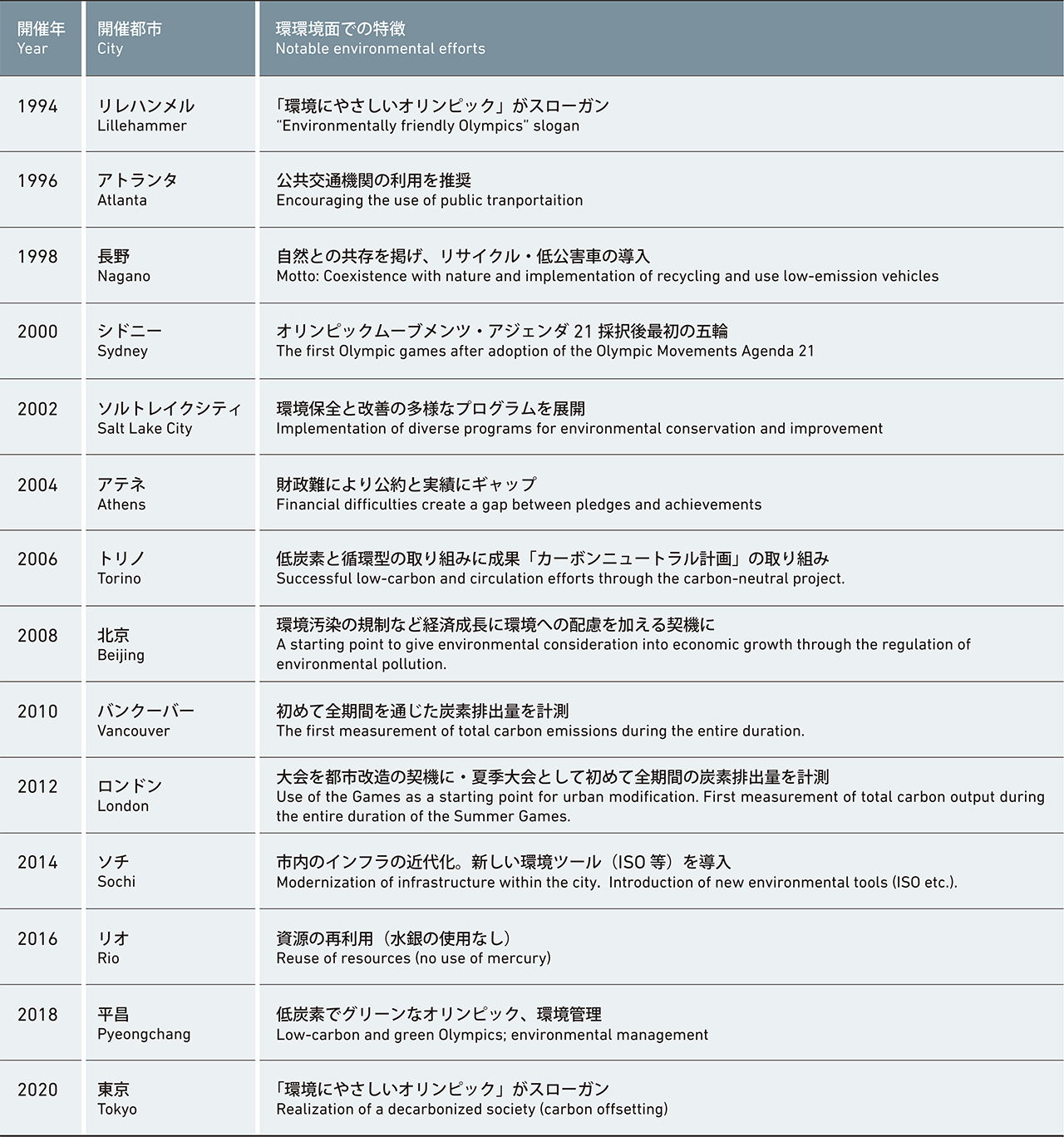
Source: Report produced by the Ministry of the Environment, August, 2014, p9
東京2020大会の Towards Zero Carbon(脱炭素社会の実現に向けて)Towards Zero Carbon: Decarbonization efforts of the Tokyo 2020 Games
このコーナーでは、東京2020大会が環境に配慮したやさしいオリンピックレガシーをどのように築きあげているのか、A)カーボンフットプリントの把握、B)会場の見直しなどによる回避策と削減策、そしてC)カーボンオフセット(相殺)の3つの側面を中心に見ていきます。
The Tokyo 2020 Games are to focus mainly on three aspects: A) identification of carbon footprint, B) emission avoidance and reduction measures through venue re-planning, and C) carbon offsetting.
東京2020大会のCO₂見える化:
A) カーボンフットプリントCO₂ visualization for the Tokyo 2020 Games:
A) Carbon footprint
東京2020大会において、回避策実施前に排出される CO₂等は約301万トン、回避策実施後の排出量は約293万トン。これは、新設会場の建設中止で既存施設の活用を含む会場見直しの効果が建設部門で見られ、約8万トンの削減効果となりました。それでも、会場建設に関連する排出量が全体の半分を超えています(右下表)。
The emissions estimate of CO₂ before implementation of avoidance measures was about 3,010,000 t. This was reduced to about 2,930,000 t after implementation. This decrease was a result of venue re-planning in the construction division, including decisions to use preexisting facilities after cancelling construction of new venues resulting in a CO₂ reduction of about 80,000 t. However, emissions involved in venue construction accounts for more than half of the total (Table to the rightbelow).
カーボンフットプリント(定義については下記の参照ページで確認しよう!)の算定対象となる項目は下表のとおりですが、見直し後も排出が回避されていない運営部門や観客部門の抜本的な見直しが必要となるのではないでしょうか。
The Table shows the calculated carbon footprint for various activities. Even after re-planning, emissions could not be avoided in the operation and spectator divisions. Isn’t drastic re-planning in these divisions necessary?

運営計画 第二版(素案) 気候変動パート抜粋」2018 年3 月26 日、3 頁をもとに作成。 Source: Report produced by the Tokyo Organizing Committee, March 26th 2018, p.3.
日本のCO₂等の年間排出量はどのくらいなのでしょうか?
What is the annual amount of CO₂ etc. emissions in Japan?
https://www.env.go.jp/earth/ondanka/ghg-mrv/emissions/mat190704.pdf
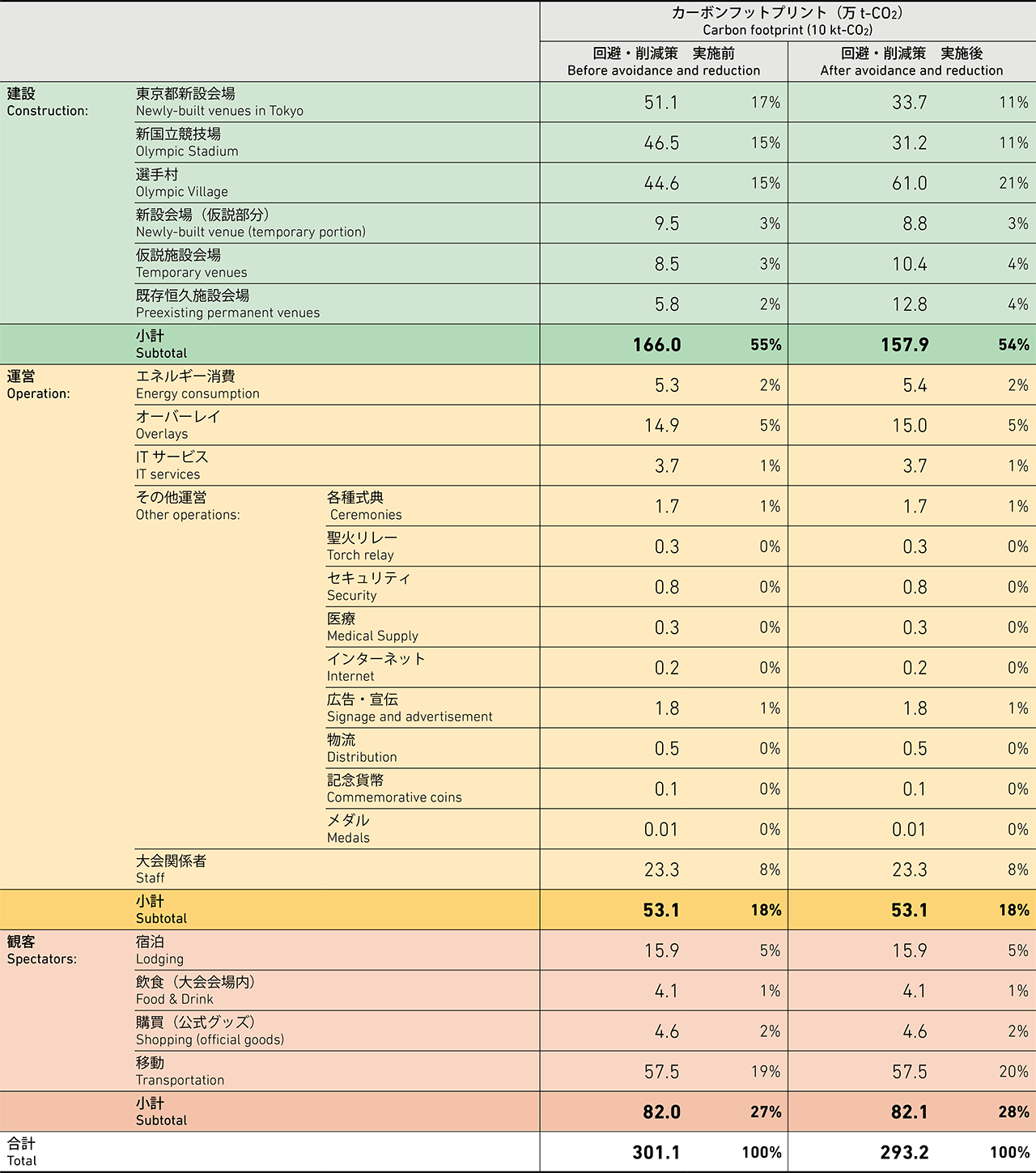
Source: Hiroyuki Uchida “CO₂ Visualization and Climate Change Countermeasures for the Tokyo Olympics and Paralympics” Mizuho Information & Research Institute Report vol. 16 2018 p. 6
東京2020大会のCO₂対策:
B)削減策[再生可能エネルギー(再エネ)の利用目標100%]CO₂ countermeasures for the Tokyo 2020 Games:
B) Reduction measures-procuring 100% of electric power from renewable energies
東京都は長期目標として「スマートエネルギー都市の実現」を掲げており、再生可能エネルギーの活用が東京2020大会でも導入されています。具体的には、7つの会場には太陽光発電設備、そのうち4会場には太陽熱利用設備、3会場には地中熱利用設備も設置し、選手村の主要施設では、水素ステーションも含む多様なエネルギーの活用による改革が注目を集めています。もちろん、運営中には膨大なエネルギーを消費する大会であるため、新規に調達せざるを得ない電力が発生しますが、これらはグリーン電力と呼ばれる自然エネルギー(風力、太陽光、水力、バイオマス等)により発電された電力を外部より調達し、100%再エネ化を図っています。
The Tokyo Metropolitan Government upholds a long-term objective to “realize a smart-energy city.” Therefore, the use of renewable energies is adopted for the Tokyo 2020 Games as well. Solar photovoltaic systems are being installed in seven venues: four using solar thermal systems, and three using geothermal heating/cooling systems. In addition, key facilities of the Olympic Village will be equipped for use of diverse types of energy, including a hydrogen power station. Such radical implementations are currently gaining attention. The Games will be augmented by “green electricity,” which is generated by natural energies (wind power, solar power, hydropower, biomass, etc.) from outside sources. The aim is to use 100% of power from renewable energy sources.
《7会場》新国立競技場、有明アリーナ、有明テニスの森、大井ホッケー競技場、海の森水上競技場、オリンピックアクアティクスセンター、武蔵野の森総合スポーツプラザ
Seven venues: Olympic Stadium, Ariake Arena, Ariake Tennis Park, Oi Hockey Stadium, Sea Forest Waterway, Tokyo Aquatics Centre, and Musashino Forest Sports Plaza.
日本の再エネ普及について考えてみよう
Let’s think about the widespread use of renewable energies in Japan.
https://www.enecho.meti.go.jp/category/saving_and_new/saiene/renewable/outline/index.html
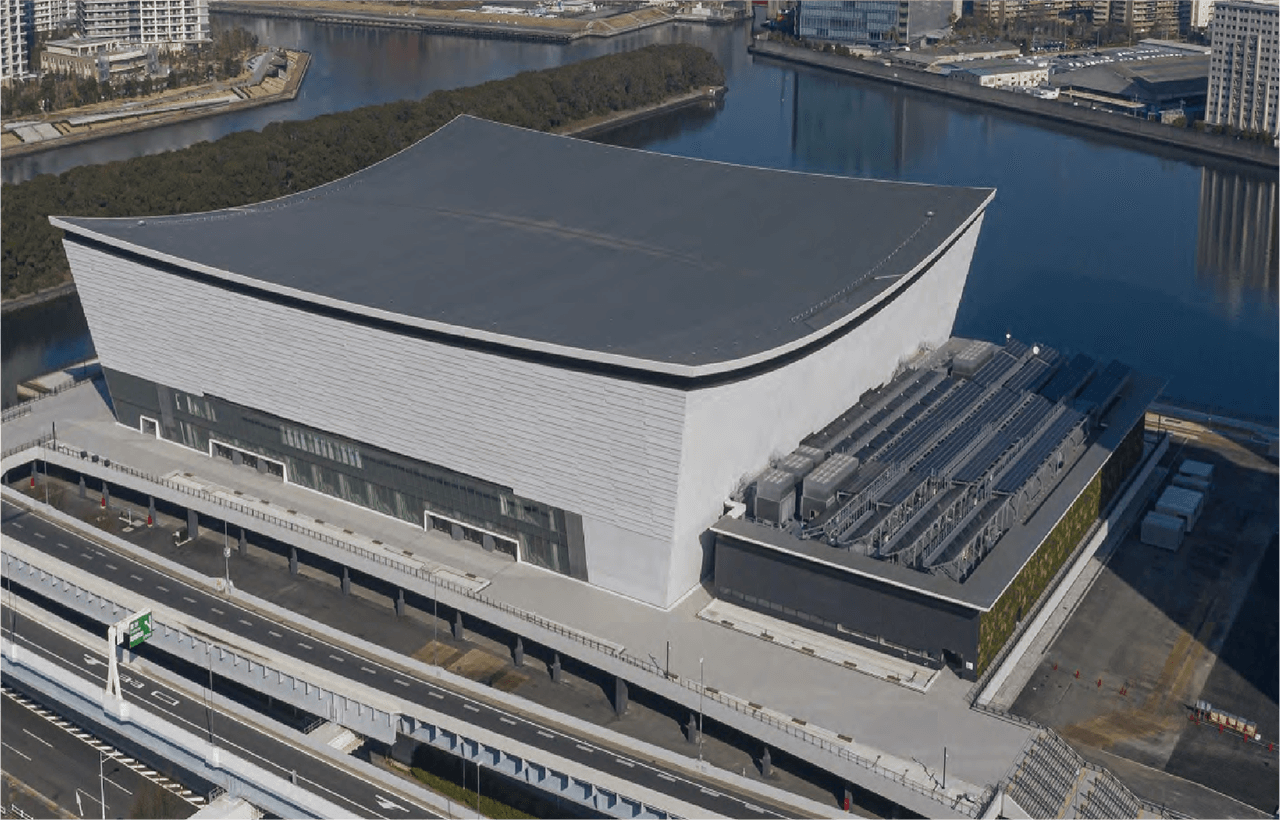
出典/Source: Photo/Map: Arne Müseler / arne-mueseler.com / CC-BY-SA-3.0 /
東京2020大会のCO₂対策:
C) カーボンオフセットCO₂ countermeasures for the Tokyo 2020 Games:
C) Carbon offsetting
脱炭素対策として、「回避策」、「削減策」が取られたとしても、削減が厳しいとされる残りの CO₂等(約293万トン)については、「オフセット(相殺)策」が計画されています。この「カーボンオフセット」は、東京2020夏季大会で初めての取組みとなります。
東京都は、2010年より、世界で初めてオフィスビル等を対象に CO₂等排出量に上限(キャップ)を設定し、キャップ・アンド・トレード制度より削減された排出量を大規模事業者に寄付してもらい、オフセットに活用しています。パリ協定の目標にのっとり、厳格な基準により実現できた寄付のみが使用されています。これを、新たなレガシーとしてパリ・ロサンゼルスへとつなげていきます。
A pioneering “carbon offsetting measure” for the removal of the residual 2,930,000 t of CO₂ emissions after the “avoidance” and “reduction” measures is planned for the Tokyo 2020 Summer Games.
Since 2010, the Tokyo Metropolitan Government (TMG) has capped emissions of CO₂ by office buildings through a cap-and-trade system. Thus, TMG receives emissions reduced by large enterprises as donations for offsetting. TMG is the first government in the world to implement this measure. TMG uses only donations of reduction that satisfy strict criteria that guarantees transparency, traceability, and solidity in accordance with the Paris Agreement. The Tokyo 2020 Games will pass on this practice to the Games in Paris and Los Angeles as a new Olympic legacy.
東京 2020 大会のカーボンオフセット(定義については下記の参照ページを確認しよう!)には様々な提案があります。キャップ・アンド・トレード制度に参加する事業者の事例についても詳しく調べてみよう
Various proposals have been made for carbon offsetting for the Tokyo 2020 Games (check reference material for the definition of carbon offsetting!). Take a closer look at some examples of corporate participation in the cap-and-trade system!
https://www.env.go.jp/policy/hozen/green/ecolabel/a05.html
https://www.kankyo.metro.tokyo.lg.jp/climate/zenpan/tokyogreenbuild2015.files/P14-15.pdf
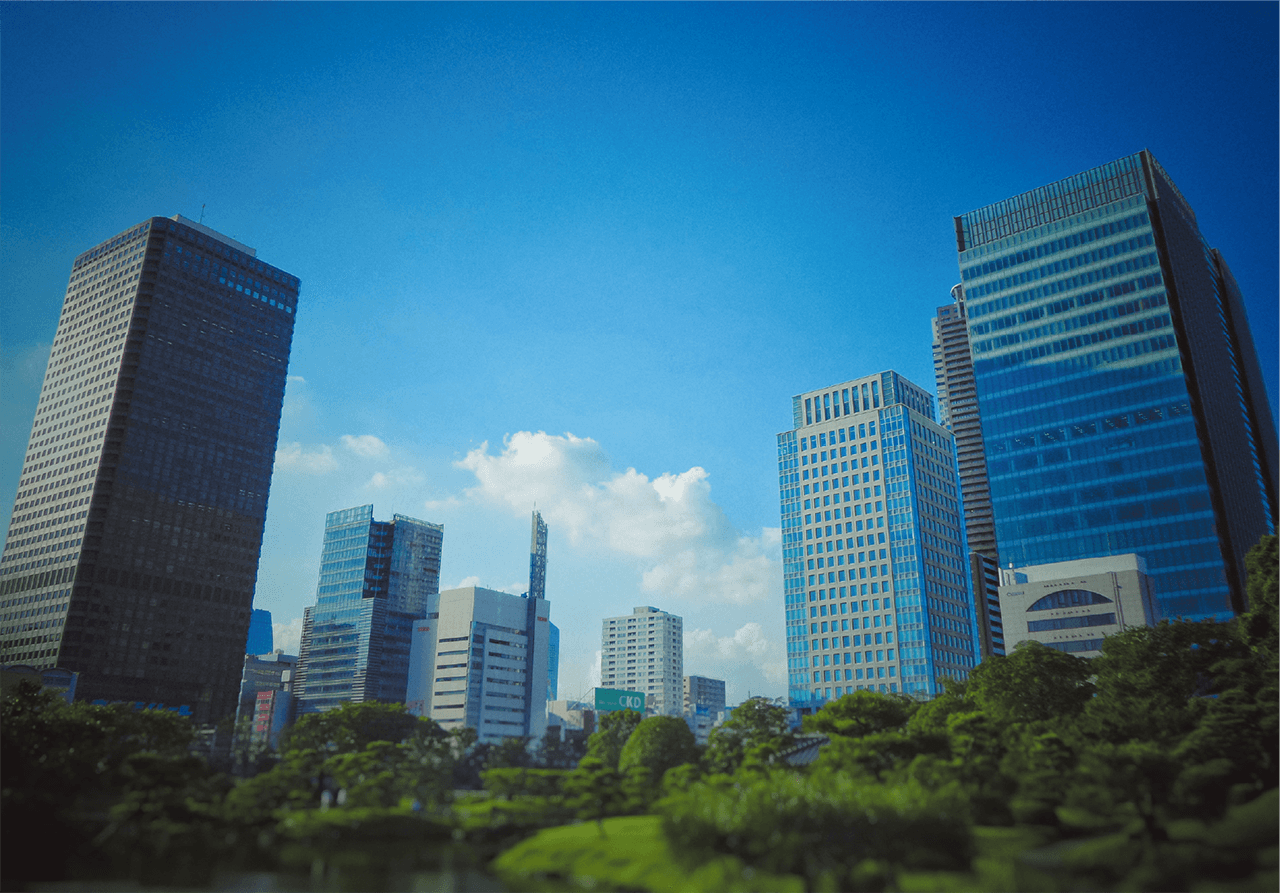
Source: flickr[Tokyo], https://www.flickr.com/photos/cc0/33746128751/ retrieved January 31st, 2020
持続可能性のアクション
プラスチック空き容器からつくる!
「みんなの表彰台プロジェクト」Recycled Plastic Victory–Ceremony Podium Project
近年、国内でも特にプラスチックの大量消費と大量廃棄が問題視されていることは皆さんにとっても身近ではないでしょうか。また、海洋プラスチック汚染が喫緊の課題となる中、使い捨てプラスチックを活用した「みんなの表彰台プロジェクト」が実施されました。家庭で使用済プラスチックを回収し、表彰台を製作するプロジェクトは、オリンピック・パラリンピック史上、東京2020大会が初めてとなります。
Plastic disposal and the resultant plastic pollution in oceans are serious concerns. The Recycled Plastic Victory–Ceremony Podium Project was implemented to recycle plastic waste from households and foster a sustainable society. Tokyo 2020 will be the first in the history of the Olympics and Paralympics to build podiums made from used plastic collected from households.
国連環境計画(UNEP)によれば、日本は、1人が排出する使い捨てプラスチックごみ量が、米国に次いで世界で 2 番目に多い。これからどうする?
According to the United Nations Environment Programme (UNEP), Japan ranks second in the world after the United States in terms of per capita single-use plastic waste.
What should we do about this situation?
https://www.unic.or.jp/news_press/features_backgrounders/28946/

都市鉱山からつくる!
「みんなのメダルプロジェクト」
東京2020大会のアスリートたちに授与されるメダルは、使用済み携帯電話等の金属を集め、小型家電のリサイクル化を試みています。このプロジェクトでは、2017年4月からの2年間で約5,000個の金・銀・銅のメダルに必要な金属量を100%回収することができました。この成果をレガシーとして活用し,「アフターメダルプロジェクト」を環境省が実施しています。
This is the first project in the history of the Olympics to manufacture the medals that will be awarded to the athletes at the Games from metals collected from small and used electrical appliances such as mobile phones. Beginning from April 2017, 100% of the gold, silver, and copper necessary to make about 5,000 medals were successfully collected. Additionally, the Ministry of Environment is applying the legacy of this project to an “After Medal Project.”
都市鉱山ってなんだろう?
What is an urban mine?
https://www.env.go.jp/guide/info/ecojin/issues/17-11/17-11d/tokusyu/2.html
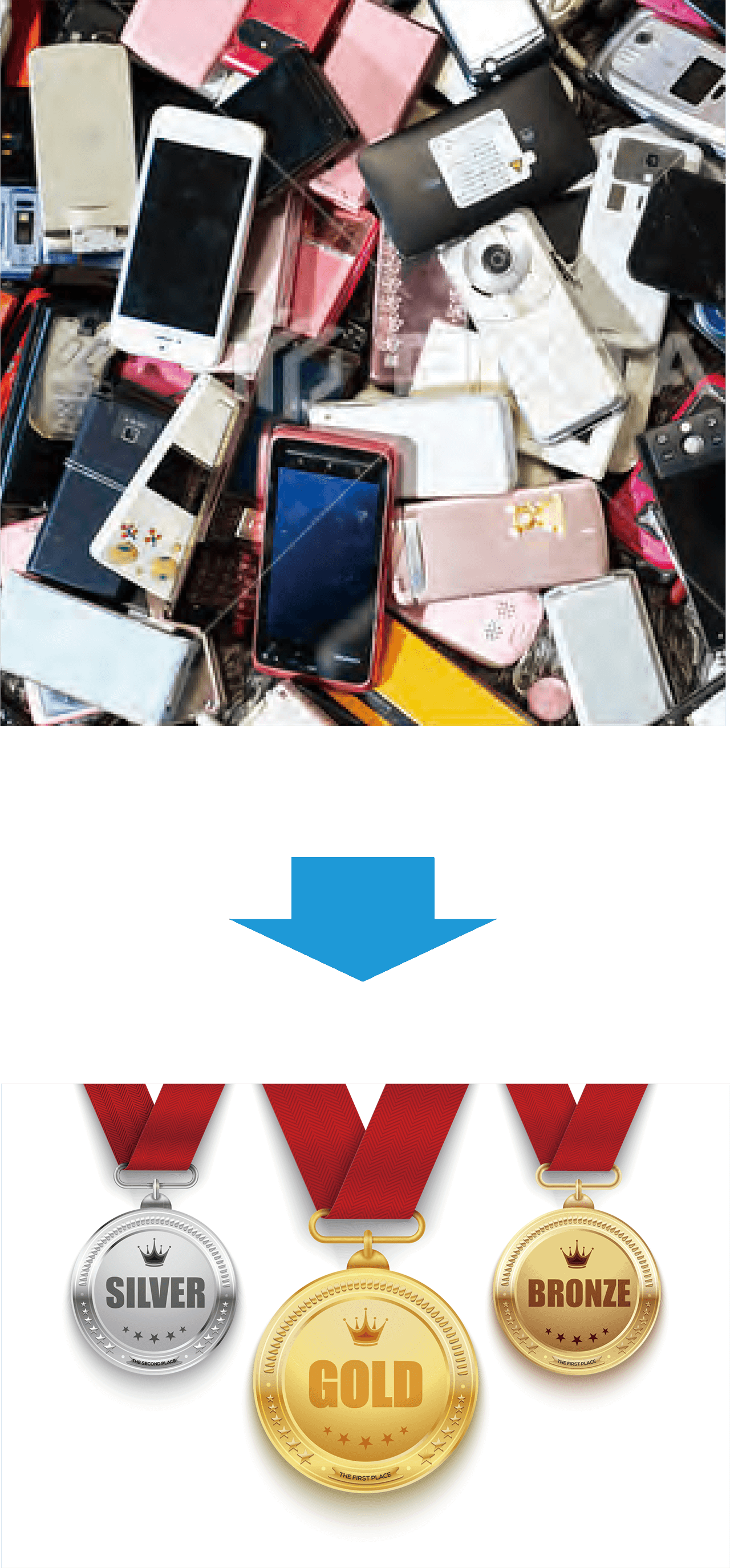
アンケート
アンケートへのご協力をお願いいたします。
